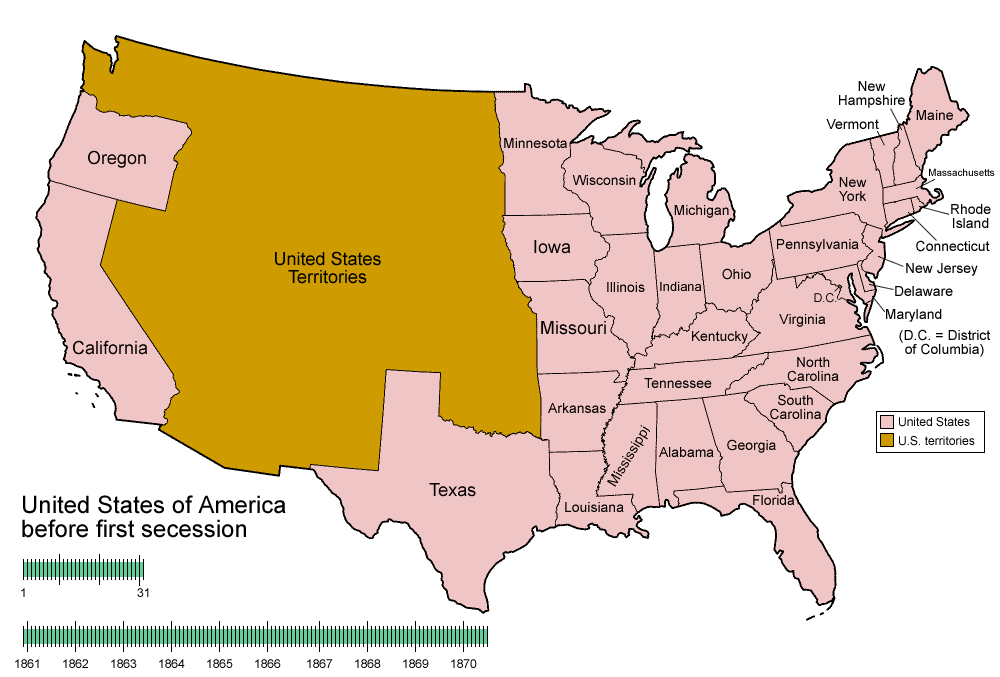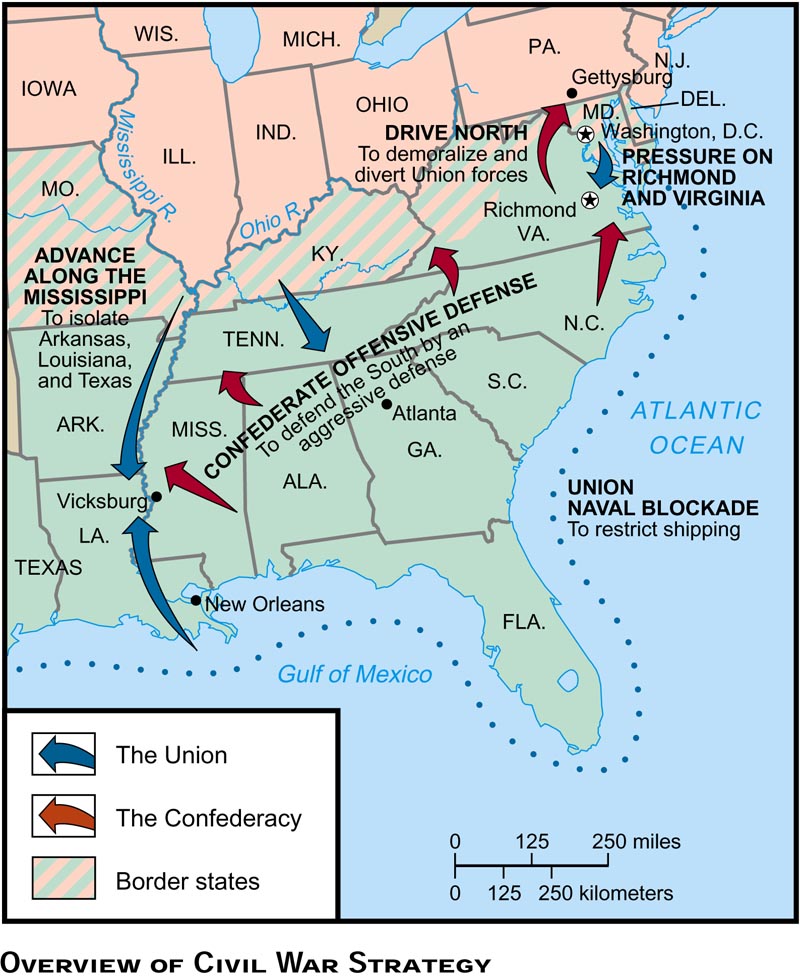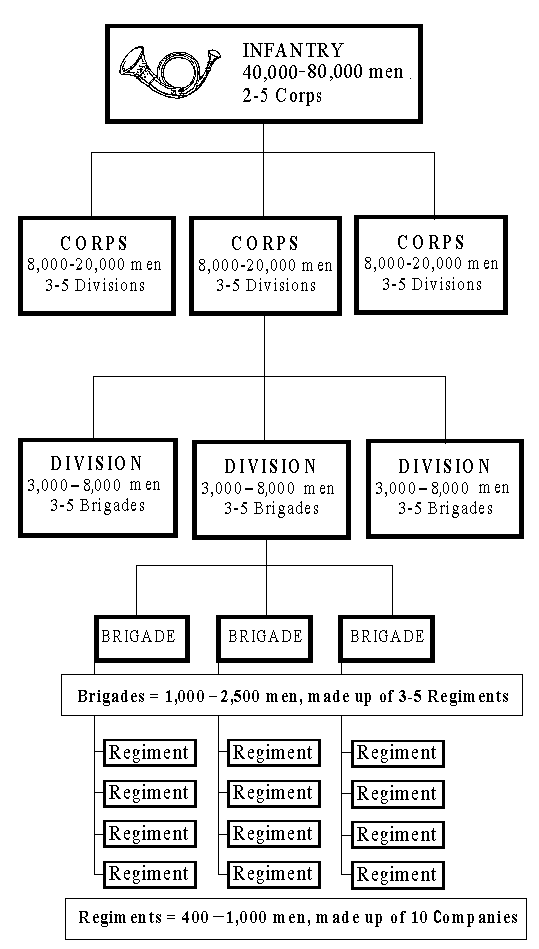
|

|
Civil War Army
The Military of the North and South
Union and Confederate Armies
Civil War Northern Army and Southern Military
Civil War Army
As both the North and the South mobilized for Civil War, the relative strengths
and weaknesses of the "free market" and the "slave labor" economic systems became increasingly clear - particularly in their
ability to support and sustain a war economy. The Union's industrial and economic capacity soared during the war as the North
continued its rapid industrialization to suppress the rebellion. In the South, a smaller industrial base, fewer rail lines,
and an agricultural economy based upon slave labor made mobilization of resources more difficult. As the war continued, the
Union's advantages in factories, railroads, and manpower put the Confederacy at a great disadvantage.
Nearly every sector of the Union economy witnessed increased production.
Mechanization of farming allowed a single farmer growing crops such as corn or wheat to plant, harvest, and process much more
than was possible when hand and animal power were the only available tools. (By 1860, a threshing machine could thresh 12
times as much grain per hour as could six men.) This mechanization became even more important as many farmers left home to
enlist in the Union military. Those remaining behind could continue to manage the farm through the use of labor-saving devices
like reapers and horse-drawn planters.
Northern transportation industries boomed during the conflict as well--particularly
railroads. The North's larger number of tracks and better ability to construct and move parts gave it a distinct advantage
over the South. Union forces moving south or west to fight often rode to battle on trains traveling on freshly lain tracks.
In fact, as Northern forces traveled further south to fight and occupy the Confederacy, the War Department created the United
States Military Railroads, designed to build rails to carry troops and supplies as well as operating captured Southern rail lines and equipment. By war's end, it was the world's largest railroad system.
| Comparison of the North and South and Civil War |

|
| Compiled data indicating vast differences between Northern and Southern states during Civil War |
Other Northern industries--weapons manufacturing, leather goods, iron production,
textiles--grew and improved as the war progressed. The same was not true in the South. The twin disadvantages of a smaller
industrial economy and having so much of the war fought in the South hampered Confederate growth and development. Southern
farmers (including cotton growers) were hampered in their ability to sell their goods overseas due to Union naval blockades.
Union invasions into the South resulted in the capture of Southern transportation
and manufacturing facilities.
The Southern economy, while shaky throughout the war, grew markedly worse
in its later years. The Emancipation Proclamation both enraged the South with its promise of freedom for their slaves, and
threatened the very existence of its primary labor source. The economy continued to suffer during 1864 as Union armies battered
Confederate troops in the eastern and western theaters. In the East, General Ulysses S. Grant threw men and materiel at Robert
E. Lee's depleted and increasingly desperate army. Grant took advantage of railroad lines and new, improved steamships to
move his soldiers and had a seemingly endless supply of troops, supplies, weapons, and materials to dedicate to crushing Lee's
often ill-fed, ill-clad, and undermanned army. Though the campaign eventually fell into a stalemate at Petersburg, Virginia,
Grant could afford to, as he stated, "fight it out along this line if it takes all summer," while Lee could not.
In the western theater of the war, William T. Sherman's Union troops laid
waste to much of the Georgia countryside during the Atlanta Campaign and the subsequent "March to the Sea." Sherman's campaigns
inflicted massive damage to Southern industry, agriculture and infrastructure. His soldiers destroyed rail lines and captured
the major economic and transportation hub of Atlanta and the critical seaport of Savannah. When Sherman famously telegraphed
Lincoln in December 1864, "I beg to present you as a Christmas gift the city of Savannah," his gift included "about twenty-five
thousand bales of cotton." Sherman himself later estimated that this campaign, which eventually moved north and similarly
impacted the Carolinas, caused $100 million of destruction. An already troubled Confederate economy simply could not absorb
such massive losses and survive.
As the war progressed, substantial and far-reaching changes were taking
place far from the battle lines. When Lincoln became president in March 1861, he faced a divided nation, but also a Congress
dominated by Republicans after many Southern Democratic members left to join the Confederacy. Lincoln and congressional Republicans
seized this opportunity to enact several pieces of legislation that had languished in Congress for years due to strong Southern
opposition. Many of these bills set the course for the United States to emerge by war's end as a nation with enormous economic
potential and poised for a massive and rapid westward expansion. When Southerners left Congress, the war actually provided
the North with an opportunity to establish and dominate America's industrial and economic future.
| The Civil War Army and Military |

|
| Civil War comparison of the North and South |
While Native Americans, Hispanics, Germans, and Irish fought for both the
Union and Confederacy, New York City was the largest Irish city in the world with 203,740 Irish-born out of a total population
of 805,651. Unlike the soldiers who fought in most international disputes and wars, the Civil War soldier, whether from the
North (Union) or South (Confederacy), had much in common. Some opposing soldiers, for example, including high ranking
generals and lowly privates, spoke the same language, enjoyed the same music, food and hobbies, claimed the same home
state, attended the same university, had the same surname, and were even raised in the same house. Some soldiers
were brothers but found themselves standing firm and on opposing sides of the battlefield, causing
many to refer to the conflict as the Brothers War.
Militarily, the South’s greatest advantage over the North was simply
the fact that if not attacked it could win by doing nothing. To restore the Union the Federal forces would have to conquer
the Confederacy. The difference in manpower was also critical to the outcome of the Civil War. According to the 1860 US census,
the population of the United States numbered 31,443,321. While approximately 21 million were in the North and Union held Border
States, an additional 500,000 were slaves residing in the Border States. The South, on the other hand, with merely 5.5 million
citizens was at a 4-to-1 disadvantage. The Southern states also held 3.5 million slaves.
As North and South prepared for battle, the preponderance of productive
capacity, manpower, and agricultural potential clearly lay on the side of the North. Its crops were worth more annually than
those of the South, which had concentrated on growing cotton, tobacco, and rice. Between February and May 1861 the Confederate
authorities missed the opportunity to ship baled cotton to England and draw bills against it for the purchase of arms. In
sea power, railroads, material wealth, and industrial capacity to produce iron and munitions, the North was vastly superior
to the South. This disparity became even more pronounced as the ever-tightening blockade gradually cut off the Confederacy
from foreign imports. The North had more mules and horses, a logistical advantage of great importance since supplies had to
be carried to the troops from rail and riverheads.
Yet not all the advantages lay with the North. The South possessed good
interior lines of communications; and its 3,550-mile coastline, embracing 189 harbors and navigable river mouths, was difficult
to blockade effectively. Possessors of a rich military tradition in wars against the British, Spanish, Mexicans, and Indians,
the Southerners initially managed to form redoubtable cavalry units more easily than the North and used them with considerable
skill against the invading infantry. As the war progressed, the Union and Confederate armies demonstrated high degrees of
military skill and bravery. Man for man they became almost evenly matched, and their battles were among the bloodiest in modern
history. Jefferson Davis hoped that the sympathy or even the intervention of European powers might more than compensate for
the Confederacy’s lack of material resources. This hope, largely illusory from the start, became less and less likely
of realization with the emancipation of the slaves, with every Union victory, and with the increasing effectiveness of the
blockade.
Approximately one in four soldiers that went to war never returned home. When
the Civil War commenced, neither army had mechanisms in place to handle the amount of death that the nation was about to experience. There
were no national cemeteries, no burial details, and no messengers of loss. The largest human catastrophe in American
history, the Civil War forced the young nation to confront death and destruction in a way that has not been equaled before
or since. Recruitment was highly localized throughout the war. Regiments of approximately one thousand men, the building
block of the armies, would often be raised from the population of a few adjacent counties. Because soldiers, who were
neighbors and kin, went to war, the nature of recruitment meant that a battlefield disaster could wreak havoc on the
home community.
The Civil War also influenced modern warfare on a
global scale. The use of the telegraph for instant communication, ironclad warships, such as the Monitor and Merrimack, for
naval engagements, the siege and trench warfare at Vicksburg and Petersburg, and of the railway for rapid troop
deployment all prefigured military operations during later conflicts. The Civil War also foreshadowed the age of total war,
encompassing soldiers and civilians alike. No one understood this point better than Union General William Tecumseh Sherman,
who observed: “This war differs from other wars, in this particular. We are not fighting armies but a hostile people,
and must make old and young, rich and poor, feel the hard hand of war.”
| Civil War Union and Confederate Armies |

|
| Map of Union military strategy during the Civil War |
|

|

|

|

|
From Regiment to President: The Structure and Command of Civil War Armies
Trying to determine the structure and command of a Civil War army can be
a daunting task. While designations, ranks, and commands can be difficult to understand, battlefield promotions
and deviations between different armies further muddy the waters. In an effort to provide some clarity into the subject,
we will trace the command structure from the colonel leading a regiment all the way to the office of the President as Commander-in-Chief.
Regiment
When asked what unit he was with, most Civil War soldier would respond with
the name of his regiment. The regiment was the primary fighting unit of both armies and usually carried the name of the state
of origin and the chronological number of the creation of that regiment (eg. The 6th Wisconsin would be the sixth regiment
raised by the state of Wisconsin).
A regiment was often composed of men from the same region of a state and
frequently contained men who had known each other before the war. A newly formed regiment contained about 1,000 officers and
enlisted men. Official United States Army regulations called for a regiment to consist of 10 companies, each made up of 97
men and 3 officers. Companies were commanded by a captain and designated with the letters A-K (the letter "J" was not used
because it sounded too much like "A" when shouted in battle, and when written it looked too much like "I").
A colonel commanded the regiment, followed in succession by a lieutenant
colonel and a major. The actual number of men in a regiment varied widely during the war as a result
of battle losses, disease, and desertion.
Brigade
During the Civil War a brigade was made up of
anywhere between two and six regiments, but most commonly contained four. A brigade was commanded by a brigadier general who
reported directly to the division commander. Union brigades were identified with numbers (eg. the fourth brigade) but Confederate
brigades were usually named after their current or former commanding officers (eg. "Hood's
brigade"). Brigades of both sides were also commonly identified by nicknames earned in battle (eg. the "Texas brigade" "Iron
Brigade" or "Stonewall brigade").
Division
A Civil War division contained between three and five brigades, and was
commanded by a major general. Confederate divisions tended to contain more brigades than their Union counterparts, and often
consisted of nearly twice as many men.
| Union and Confederate Army Organization |

|
| The Civil War Infantry Organization |
Corps
A corps could contain between two and four divisions, but was most commonly
made up of three. A Union Corps was commanded by a major general while a Confederate Corps was led by a lieutenant general.
Since Confederate divisions were typically larger than Union divisions, it was often the case that a single Confederate division
was nearly the same size as a Union corps.
During the Maryland Campaign the Army of Northern Virginia had not yet adopted
a Corps system but rather consisted of two wings commanded by Major Generals Jackson and Longstreet. Following the Battle
of Antietam both men were promoted to Lieutenant General and given command of the newly designated First and Second Corps
of the Army of Northern Virginia respectively.
Army
An Army was a fighting force consisting of two or more corps and was commanded by a general.
During the Civil War the Union most commonly named its armies after rivers or waterways (eg. the Army of the Potomac) while
the Confederacy designated its armies after states or regions (eg. the Army of Northern Virginia).
Beyond the Battlefield
Even the commanders of armies still had to report to those above them. During the Civil War the
presidents of the United States and Confederacy both acted as Commander in Chief and held the highest authority on military
matters. Each president also had a Secretary of War who was the official link between the President and his commanders in
the field. The Union also contained the position of the General in Chief of the Armies who officially held the highest rank
over all the military forces in the field. Despite this official chain communication between the commanders in the field often
went directly to the President as well as the Secretary of State and General in Chief of the Armies.
Examples of Chain of Command
Here are two practical examples of the chain of command from regiment to
president at the Battle of Antietam.
Union
6th Wisconsin Regiment - Lieutenant Colonel Edward S. Bragg
Fourth "Iron" Brigade - Brigadier
General John Gibbon
First Division - Brigadier General John P. Hatch
I Corps Commander - Major General Joseph
Hooker
Commander of the Army of the Potomac - Major General George B. McClellan
General in Chief of the Armies
- Henry Halleck
Secretary of War - Edwin Stanton
President - Abraham Lincoln
Confederate
1st
Texas Regiment - Lieutenant Colonel Phillip A. Work
Brigade - Colonel William T. Wofford
Division - Brigadier
General John B. Hood
Commander of the Right Wing - Major General James Longstreet
Commander of the Army of
Northern Virginia - General Robert E. Lee
Secretary of War - George W. Randolph
President - Jefferson Davis
Note: The commanders of the various elements do not always hold the expected rank. This was frequently the case
during a campaign when higher ranking officers were killed or wounded and officers of a lower rank had to replace them in
the field.
Sources: Library of Congress; National Archives; National Park Service;
Official Records of the Union and Federal Armies; 1860 United States Census; Civil War Trust; US Army Center of Military History;
C&O Canal National Historical Park; Fredericksburg and Spotsylvania National Military Park; Governor's Island National
Monument; Harpers Ferry National Historical Park; Mammoth Cave National Park; Springfield Armory National Historic Site;
Richmond National Battlefield Park; Shiloh National Military Park; Dyer, Frederick H., A Compendium of the War of Rebellion
(1908): Fox, William F. Regimental Losses in the American Civil War (1889); Phisterer, Frederick. Statistical record of the
armies of the United States (1883); Hardesty, Jesse. Killed and died of wounds in the Union army during the Civil War (1915)
Wright-Eley Co.
Return to American Civil War Homepage

|

|

|

